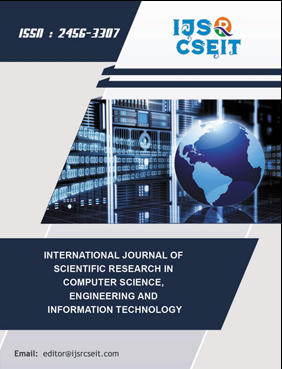Multimodal Data Integration for Early Alzheimer’s Detection Using Random Forest and Support Vector Machines
DOI:
https://doi.org/10.32628/CSEIT241047Keywords:
Alzheimer's Disease Detection, Multimodal Data Integration, Random Forest, Neuroimaging BiomarkersAbstract
Alzheimer's is a very challenging brain disease to recognize, diagnose, and treat correctly when it appears in its earliest forms. The primary contribution of this research study is about machine learning models, techniques, and approaches. In contrast, Random Forest and Support Vector Machine (SVM) are particularly suitable for identifying and staging Alzheimer's disease stages using multimodal data sources. In this paper, the aim was to develop well-performing predictive models to help diagnose Alzheimer's disease at an early stage by combining neuroimaging data (MRI/PET images), imaging-based biomarkers, both structural and functional measures from MRI(P) /PET image analysis along with subject-specific demographics like age using clinical features in a probabilistic fashion obtained from the Alzheimer's Disease Neuro-Imaging Initiative (ADNI) database. The methodology focuses on data pre-processing, feature selection, and model building using supervised learning algorithms. The accuracy of the Random Forest model is 78%, having a high performance in classifying some classes while showing different marks of performances across other courses. SVM reached an accuracy of 61%, or the model's performance is good in some classes and not reliable to identify samples from the others. The findings of this study underscore the capabilities and limits of these machine learning models in identifying Alzheimer’s disease and highlight the importance of feature engineering, data pre-processing, and model tuning to increase performance and correct class unevenness and misclassification.
📊 Article Downloads
References
C. Patterson, “World Alzheimer report 2018,” 2018.
M. W. Weiner et al., “2014 Update of the Alzheimer’s Disease Neuroimaging Initiative: a review of papers published since its inception,” Alzheimer’s & Dementia, vol. 11, no. 6, pp. e1-e120, 2015. DOI: https://doi.org/10.1016/j.jalz.2014.11.001
M. Abdar et al., “A new machine learning technique for an accurate diagnosis of coronary artery disease,” Computer Methods and Programs in Biomedicine, vol. 179, p. 104992, 2019. DOI: https://doi.org/10.1016/j.cmpb.2019.104992
P. Kishore et al., “Detection and analysis of Alzheimer’s disease using various machine learning algorithms,” Materials Today: Proceedings, vol. 45, pp. 1502-1508, 2021. DOI: https://doi.org/10.1016/j.matpr.2020.07.645
J. Cervantes et al., “A comprehensive survey on support vector machine classification: Applications, challenges and trends,” Neurocomputing, vol. 408, pp. 189-215, 2020. DOI: https://doi.org/10.1016/j.neucom.2019.10.118
D. Ali, J. J. Godhuli, B. Khan, M. T. Huque, and N. Ahmed, "Development of a system for fire detection and alarm using machine learning and computer vision."
S. Fathi et al., “A Deep Learning-Based Ensemble Method for Early Diagnosis of Alzheimer’s Disease using MRI Images,” Neuroinformatics, pp. 1-17, 2023. DOI: https://doi.org/10.21203/rs.3.rs-2858981/v1
M. Velazquez et al., “Random forest model for feature-based Alzheimer’s disease conversion prediction from early mild cognitive impairment subjects,” PLoS One, vol. 16, no. 4, p. e0244773, 2021. DOI: https://doi.org/10.1371/journal.pone.0244773
M. Song et al., “Diagnostic classification and biomarker identification of Alzheimer’s disease with random forest algorithm,” Brain Sciences, vol. 11, no. 4, p. 453, 2021. DOI: https://doi.org/10.3390/brainsci11040453
M. S. Ali et al., “Alzheimer’s disease detection using m-random forest algorithm with optimum features extraction,” in 2021 1st International Conference on Artificial Intelligence and Data Analytics (CAIDA), Apr. 2021, pp. 1-6. DOI: https://doi.org/10.1109/CAIDA51941.2021.9425212
A. Sharma et al., “Alzheimer’s patients detection using support vector machine (SVM) with quantitative analysis,” Neuroscience Informatics, vol. 1, no. 3, p. 100012, 2021. DOI: https://doi.org/10.1016/j.neuri.2021.100012
B. Richhariya et al., “Diagnosis of Alzheimer’s disease using universum support vector machine based recursive feature elimination (USVM-RFE),” Biomedical Signal Processing and Control, vol. 59, p. 101903, 2020. DOI: https://doi.org/10.1016/j.bspc.2020.101903
C. S. Eke et al., “Early detection of Alzheimer’s disease with blood plasma proteins using support vector machines,” IEEE Journal of Biomedical and Health Informatics, vol. 25, no. 1, pp. 218-226, 2021. DOI: https://doi.org/10.1109/JBHI.2020.2984355
Breiman, L., “Random forests,” Machine learning, vol. 45, no. 1, pp. 5-32, 2001. DOI: https://doi.org/10.1023/A:1010933404324
Vapnik, V. N., Statistical learning theory. New York: Wiley, 1998.
Weng, Y., Wu, C., Jiang, Q., Guo, W., & Wang, C., “Application of support vector machines in medical data,” in 2016 4th International Conference on Cloud Computing and Intelligence Systems (CCIS), pp. 200-204, IEEE, 2016. DOI: https://doi.org/10.1109/CCIS.2016.7790253
Raghavendra, U., Acharya, U. R., & Adeli, H., “Artificial intelligence techniques for automated diagnosis of neurological disorders,” European neurology, vol. 82, nos. 1-3, pp. 41-64, 2020. DOI: https://doi.org/10.1159/000504292
D. Ali, B. Younis, and S. Iqbal, "A deep learning technique for classifying images of brain tumor," Exceed Journal of Biological and Computer Sciences, vol. 1, no. 1, 2024.
D. Ali, M. T. Huque, J. J. Godhuli, and N. Ahmed, "Detection of face emotion and music recommendation system using machine learning," International Journal of Research and Innovation in Applied Science, vol. 7, no. 11, pp. 05-08, 2022. DOI: https://doi.org/10.51584/IJRIAS.2022.71101
Downloads
Published
Issue
Section
License
Copyright (c) 2024 International Journal of Scientific Research in Computer Science, Engineering and Information Technology

This work is licensed under a Creative Commons Attribution 4.0 International License.




